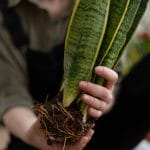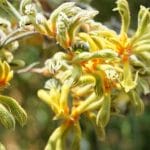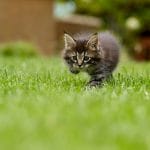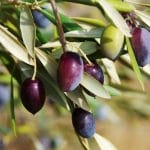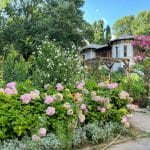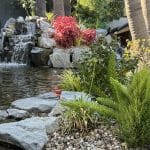Build a Frog-Friendly Pond for Natural Pest Control
Ponds & Water Features
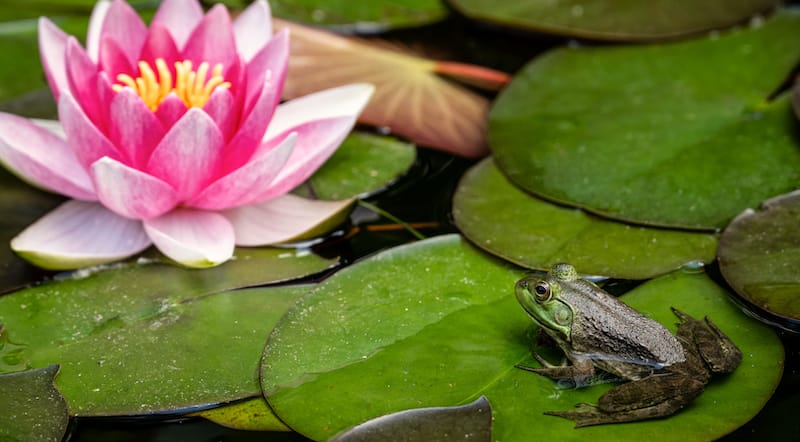
Why Frogs Belong in Our Backyards
Frogs are avid hunters and can devour lots of insects in a night. Toads are steady hunters that eat beetles, cutworms, and grubs like it’s a backyard buffet.
They also tell you something. Frogs are bioindicators: if they’re thriving in your yard, it means the water is clean, the soil is healthy, and your little patch of earth is pulling its weight in the bigger ecosystem. And then there’s the soul of it. A summer night with a frog chorus grounds you in the season the way that the first peeper call in spring cuts through the cold.
How to Build a Frog-Friendly Pond
You don’t need a landscaper or a koi pond to make it happen. Frogs are practical little creatures. They want shallow water, safe edges, and plants.
- Size & Depth: A pond ~3 feet wide and about 18–24 inches deep is plenty. Give at least one side a gentle slope so frogs (and anything else) can get in and out.
- Plants: Marginals (iris, cattails, rushes) at the edges; floaters (lilies, frogbit, duckweed) for shade; a few submerged oxygenators (hornwort, anacharis) to keep water healthy.
- Shelter: Add a log, a rock pile, or a clay pot on its side near the water’s edge. Frogs need cool hideouts during the day.
- Fish: Best not to. Even small goldfish eat eggs and tadpoles. If you really want fish, choose tiny native minnows and understand you’ll lose some frog spawn.
Keeping Pond Water Clear (Without Chemicals)
A frog pond isn’t meant to look like a swimming pool. It should feel alive — a little algae, a few leaves, plenty of plants. The trick is balance.
- Plants are the real filter. Floating leaves block sun (slowing algae), marginals pull nutrients, and submerged plants add oxygen and shelter. Aim for about half the surface shaded in summer.
- Let it breathe. A gentle bubbler or small trickle helps circulation without turning the pond into a current. Tadpoles need calm water.
- No fish, no chemicals. Fish reduce frog success, and chemical fixes pass straight through frog skin. Lean on plants, shade, and patience.
- Gravel over muck. Spread a thin layer of gravel across the bottom. Tadpoles treat it like a grazing field, and it keeps the pond floor cleaner.
- Sun + shade. Too much sun grows algae; too much shade weakens plants. A mix of both keeps things steady.
- Easy maintenance. Scoop excess leaves in fall (leave a little for overwintering spots), and let rain top it up when it can. Encourage dragonflies — they’re the mosquito patrol.
Designing a Pond Where Frogs Can Thrive
Frogs are a favorite snack for lots of creatures — from cats and raccoons to snakes and hawks. That shows how important they are in the food web. You can’t keep every hunter away, but you can give frogs plenty of safe places to slip into and thrive.
What Happens When Frogs Find You Anyway
- Shallow shelves and planting ledges for instant cover.
- Leafy, messy edges — tall grasses, ferns, shrubs — to create a green curtain.
- Floating cover like lilies or a small bark raft.
- Underwater hideouts (a hollow log or clay pot on its side in the shallows).
- Rocky retreats with flat stones stacked for crevices.
- Multiple exits (flat stones/logs/ramps) so a startled frog isn’t cornered.
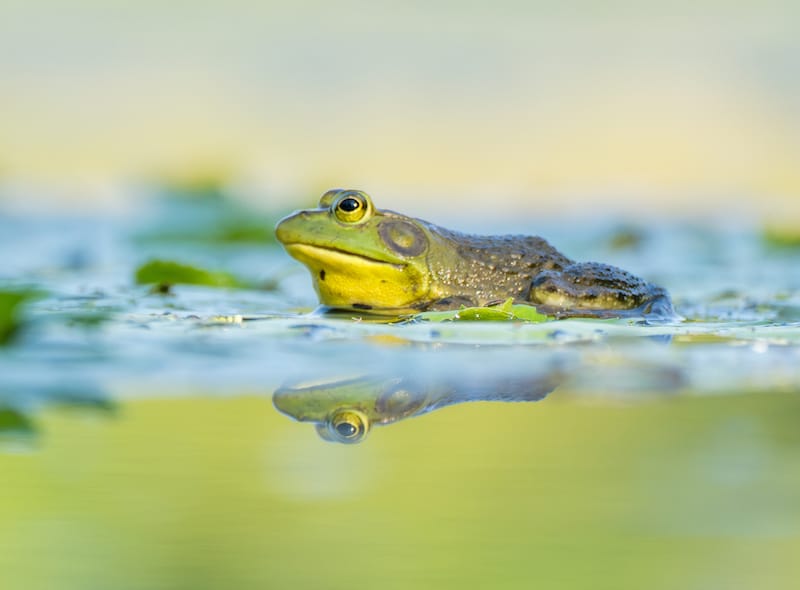
The Life of a Frog
Here’s the funny part: frogs will turn up whether you mean to host them or not. I once built a deck and craned in a hot tub — big job, a lot of work. A year later I pop the cover, and there are frogs in the tub, perfectly pleased with themselves. If they’ll colonize a tub, they’ll definitely find a natural pond you put in for them.
- Eggs: Hundreds to thousands. Toads lay strings; frogs lay clumps.
- Tadpoles: Algae grazers at first; then legs, then lungs.
- Young frogs: Tiny and vulnerable; hide in damp soil and leaf litter.
- Adults: Many live 4–10 years; bullfrogs can stretch to 16.
How Frogs Find Ponds
Frogs don’t use maps. They follow sound, moisture, maybe even scent. Many return to the pond where they hatched. Most stay within a few hundred feet of water, but some — like leopard frogs or Woodhouse’s toads — will roam a mile or two on rainy nights. That’s why small backyard ponds matter. They’re stepping stones.
Species You Might See
(Quick scan first; details below the chart.)
[Insert “Frogs by Region: Quick Reference” HTML component here]
Frogs by Region: Quick Reference
Sizes are adult length. Lifespans are typical wild ranges. Egg counts are per clutch.
| Species | Region | Size | Lifespan | Eggs / Clutch | Call |
|---|---|---|---|---|---|
| American Toad | Northeast & Midwest | 2–4 in | 5–10 yrs | 4,000–8,000 | Long trill |
| Spring Peeper | Northeast & Midwest | 1–1.5 in | 3–4 yrs | 800–1,000 | High “peep” |
| Green Frog | Northeast & Midwest | 2–4 in | 6–10 yrs | Up to 4,000 | “Banjo twang” |
| Northern Leopard Frog | Northeast & Midwest | 2–4.5 in | Up to 9 yrs | 5,000–6,000 | Chuckling/snore |
| Southern Leopard Frog | Southeast | 2–3.5 in | ~6 yrs | 3,000–5,000 | Chuckling/squawk |
| Green Treefrog | Southeast | 1.5–2.5 in | 2–5 yrs | ≈400 | Nasal “queenk” |
| American Bullfrog | Southeast | Up to 8 in | 8–16 yrs | 20,000+ | Deep “jug-o-rum” |
| Pacific Treefrog | West & Southwest | 1–2 in | 2–4 yrs | 500–750 | Classic “ribbit” |
| California Red-legged Frog | West & Southwest | 2–5 in | 7–10 yrs | Up to 5,000 | Soft grunts |
| Woodhouse’s Toad | West & Southwest | 3–5 in | 5–10 yrs | 10,000–25,000 | Nasal “waaah” |
| Great Plains Toad | Great Plains | 3–4.5 in | Up to 10 yrs | Up to 45,000 | Machine-gun trill |
| Boreal Chorus Frog | Rockies | 1–1.5 in | 3–5 yrs | 500–1,500 | Raspy comb trill |
| Columbia Spotted Frog | Rockies | 2–4 in | 10+ yrs | 500–2,000 | Low chuckles |
Note: Fish reduce frog success. For wildlife ponds, skip koi/goldfish; lean on plants, shade, and a gentle bubbler instead.
Conservation Matters
Frogs are disappearing worldwide — pesticides, drained wetlands, disease — all of it adds up. A backyard pond won’t solve everything, but it gives frogs one more place to breed and feed. Each safe, chemical-free pond is a dot on the map. Link enough dots and frogs can move across neighborhoods again. Conservation isn’t always grand. Sometimes it’s skipping the bug spray, planting natives, and leaving that messy corner by the fence.
Frog-Friendly Pond FAQ
Do frogs eat mosquitoes?
Yes. And beetles, slugs, and caterpillars, too. Dragonflies also help control mosquitoes, so a pond with both is the ideal combination.
Will frogs survive winter in a backyard pond?
Yes, if it’s 18–24 inches deep. Many hibernate under the mud or in nearby leaf litter.
Do I need fish in a frog pond?
No. Fish eat eggs and tadpoles. Frogs and plants are all you need.
How far do frogs travel to find ponds?
Usually a few hundred feet. Some, like leopard frogs, will wander up to a mile or two.
Do frogs need moving water?
No. They prefer calm ponds. A small bubbler is fine, but avoid fountains.
Share this post
Table of Contents
- Why Frogs Belong in Our Backyards
- How to Build a Frog-Friendly Pond
- Keeping Pond Water Clear (Without Chemicals)
- Designing a Pond Where Frogs Can Thrive
- What Happens When Frogs Find You Anyway
- The Life of a Frog
- How Frogs Find Ponds
- Species You Might See
- Frogs by Region: Quick Reference
- Conservation Matters
- Frog-Friendly Pond FAQ
All categories
More From The Garden
Disclosure: This post may contain affiliate links. That means if you click and buy, The Bright Garden may earn a small commission, at no extra cost to you. We only recommend products we’ve vetted and believe will benefit our readers.

